What is Referral Lead? How to Acquire More Referral Program Leads for eCommerce?
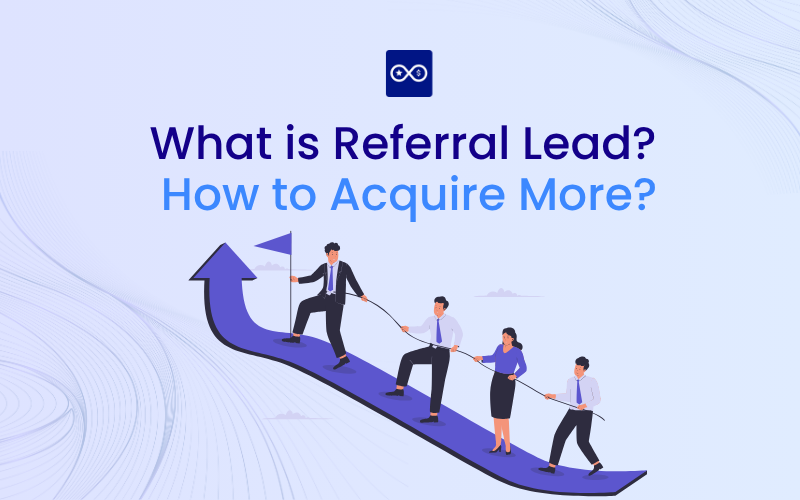
Ever wondered why some eCommerce stores seem to grow effortlessly through word of mouth? The secret often lies in referral leads. A referral lead is simply a potential customer who comes to your store because someone they trust, like a friend, family member, or happy customer, recommended it. Unlike cold leads, these referrals already have a level of trust built in, making them more likely to convert. In this article, we’ll break down exactly what referral leads are, why they matter for eCommerce, and practical ways you can acquire more of them through referral programs. Explore now!
>> Read more:
- 100+ Referral Program Glossary You Need To Know in 2026
- How To Promote a Referral Program For Your Shopify Stores? (15+ Free & Paid Tactics That Work)
What is referral lead?
A referral lead is a potential customer who comes through a personal recommendation or referral from someone in your existing network, such as a satisfied customer or business partner. Unlike regular leads, which are general potential customers needing nurturing and follow-up, referral leads have a built-in level of trust and credibility because they come with a personal endorsement. This trust makes referral leads more likely to convert into customers and often have a shorter sales cycle and higher lifetime value compared to leads generated through other marketing efforts.
Characteristics of Referral Leads:
- They are introduced by someone who trusts both the business and the potential customer.
- They come with a warmer, more direct introduction.
- They typically convert at higher rates and are less likely to churn.
- They often result from formal referral programs incentivizing recommendations.
>> Explore: Why Referral Programs Work? The Psychology Behind & How to Apply for E-commerce
Benefits of referral lead program
The benefits of a referral lead program, especially for e-commerce businesses, are substantial and impactful across multiple dimensions:
- Lower Customer Acquisition Costs (CAC): Referral programs leverage your existing customers to bring in new ones, which reduces reliance on expensive ads and campaigns. You only reward referrals when they convert, making it a cost-efficient acquisition channel.
- Attract High-Intent, High-Value Customers: Customers tend to refer friends who they believe will genuinely appreciate your product, bringing in leads with a higher likelihood to convert and become loyal customers. These leads have a more personalized fit to your brand than cold marketing leads.
- Builds Strong Trust and Credibility: Referrals come with a personal recommendation, which is the most trusted form of advertising. This trust significantly shortens the sales cycle and increases conversion rates.
- Increase Customer Lifetime Value (LTV): Referral programs encourage repeated engagement; both the referrer and referee tend to make more purchases and stay loyal longer, driving greater lifetime value.
- Creates a Sustainable Growth Loop: A well-run referral program creates a self-reinforcing cycle: happy customers bring in more customers who also become advocates, fueling continuous growth without proportional increases in marketing spend.
- Enhances Brand Awareness and Community Building: Referral programs amplify word-of-mouth, increasing organic brand reach. Over time, it builds a community of brand advocates who spread positive impressions and deepen customer loyalty.
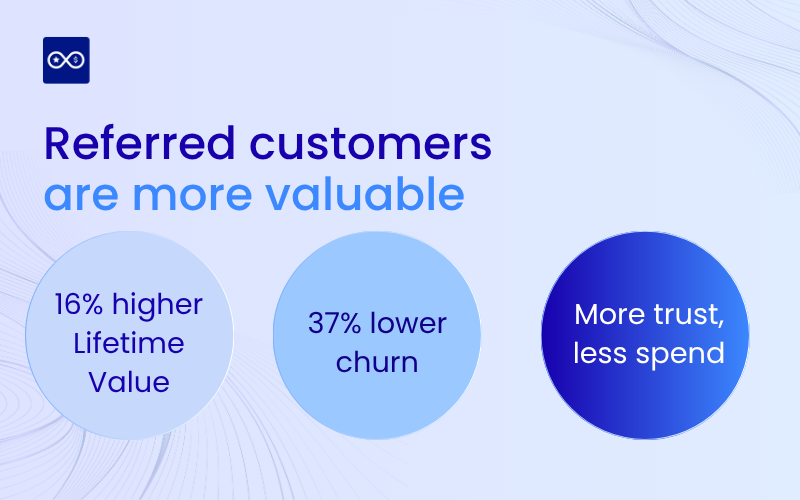
How do referral leads differ from marketing leads?
Referral leads differ from marketing leads primarily in how they originate, their qualification level, and the trust associated with them.
| Aspect | Referral Leads | Marketing Leads |
| Source | Personal recommendations | Marketing campaigns and outreach |
| Qualification | Pre-qualified with trust and endorsement | Usually unqualified, need nurturing |
| Conversion Rate | Higher due to built-in trust | Lower, often cold contacts |
| Sales Cycle | Shorter, warmer introduction | Longer, requires more follow-up |
| Cost Efficiency | Higher ROI, lower acquisition cost | May have lower upfront cost but less effective |
Origin and Source
- Referral leads come through personal recommendations or introductions from someone the potential customer knows and trusts, like a current customer or business partner.
- Marketing leads are generated through broader marketing activities such as advertising, social media, events, or content marketing, often reaching a cold or unfamiliar audience.
Qualification and Trust
- Referral leads are pre-qualified because they come with a personal endorsement, meaning the lead is more likely to have a genuine interest and fit the customer profile.
- Marketing leads are typically unqualified and require nurturing and follow-up because they may not be ready to buy or even aware of the product or service beforehand.
Conversion and Cost Efficiency
- Referral leads tend to have higher conversion rates and a shorter sales cycle due to the trust and credibility built in through the referral.
- Marketing leads often have lower conversion rates and may require more investment in follow-up and nurturing before becoming customers. However, leads can be cheaper to acquire in some cases.
What are the top channels for getting referral leads?
Referral Programs: Structured referral programs incentivize existing customers to recommend new leads, creating a reliable source of trusted leads at a low cost.
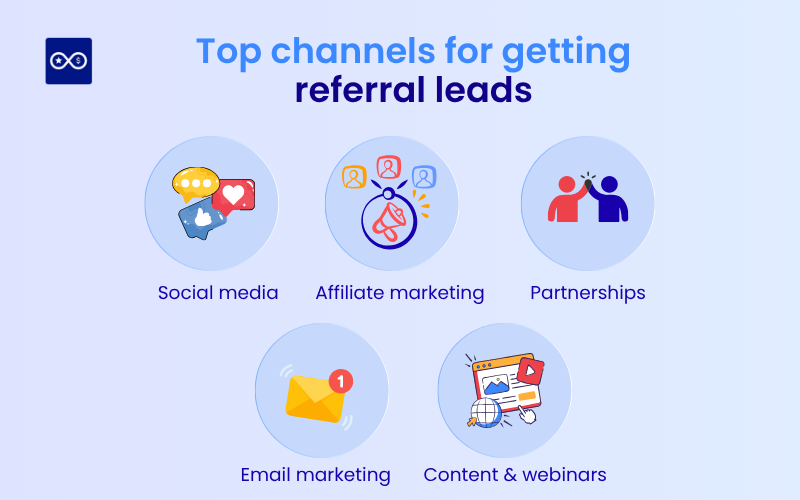
- Social Media: Platforms like LinkedIn, Facebook, and Instagram are powerful for sharing referrals within personal and professional networks, helping to spread recommendations organically.
- Affiliate Marketing: Partnering with affiliates who promote your product or service to their audience on commission helps extend reach and gain high-quality referral leads.
- Partnerships: Collaborations with other businesses or influencers that can refer qualified leads from their trusted networks.
- Email Marketing: Using existing customer lists to ask for referrals or share referral incentives can generate warm referral leads.
- Content Marketing and Webinars: Creating valuable content or hosting webinars that encourage sharing and word-of-mouth referrals can attract referral leads indirectly.
>> Read more: Referral Program vs Affiliate Program: 10+ Differences and Which is good for your brand?
How to set up a referral lead program for e-commerce?
Setting up a referral lead program for e-commerce involves several strategic steps to ensure it attracts and converts customers effectively. Here’s a step-by-step approach based on current best practices:
1. Set Clear Goals
Define what the program aims to achieve, such as the number of referrals, new customers, or revenue targets. Understand your customer lifetime value and referral rates in your industry to set realistic benchmarks.
2. Understand Customer Motivations
Identify what incentives will motivate your customers to refer others. This can be done through surveys or feedback to find out what rewards (discounts, store credit, freebies) are most appealing.
3. Choose Rewards and Incentives
Select rewards that encourage participation but are sustainable for your business. Double-sided rewards (for both the referrer and the referee) are effective, e.g., discounts for both parties. Options include coupons, store credits, free products, or gift cards.
4. Use Referral Program Tools
Utilize ecommerce referral software like Bloop Referrals & Afiliates, ReferralCandy, Friendbuy that integrate with platforms like Shopify, WooCommerce, or BigCommerce. These tools manage referral tracking, reward distribution, and marketing materials, simplifying program management.
5. Make It Easy to Refer
Create shareable links, simple referral forms, and clear instructions for customers. Embed referral widgets or buttons on your website and in emails to facilitate smooth referrals.
6. Promote the Program
Announce and promote the program across multiple channels: transactional emails (order confirmations, shipping notifications), website banners, blog posts, social media, and chatbots. Keep reminding customers about the benefits of referring friends.
7. Track and Optimize
Monitor key performance indicators (KPIs) like referral participation rate, conversion rate, and ROI. Use insights to improve incentives, messaging, and customer experience over time.
If you run a Shopify store, you can check this article about “How to Set Up a Referral Program on Shopify? (With Excel Checklist)” for deeply understanding!
How to Acquire More Referral Program Leads for eCommerce?
To acquire more referral program leads for e-commerce, businesses can follow these effective strategies:
Offer Clear and Attractive Incentives
Design a double-sided reward system that benefits both the referrer and the new customer. Popular incentives include discounts, store credits, cash rewards, or exclusive perks that motivate participation. The incentives should be appealing enough to drive referrals but sustainable for the business.
Example: Love With Food offers their referrers a free subscription box (worth $10) for each friend who signs up. The friend gets 50% off their first box, making it a win-win.
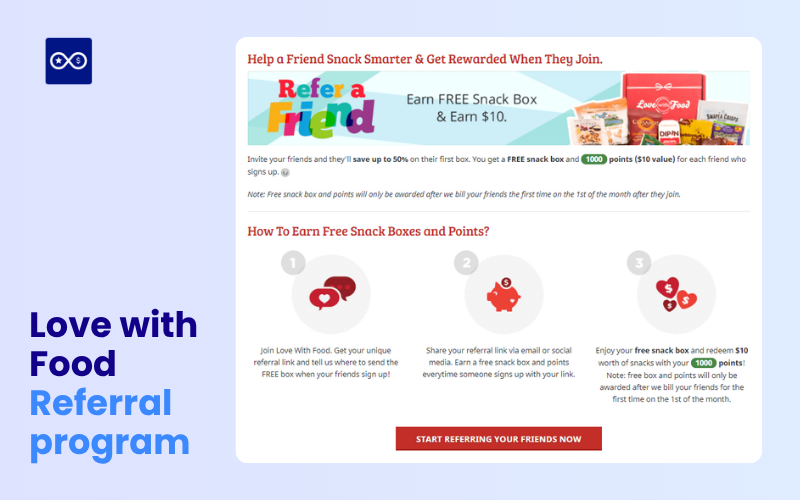
Promote Actively Across Multiple Channels
Leverage transactional emails (order confirmations, shipping notifications) to introduce and remind customers about the referral program. Use website banners, pop-ups, social media campaigns, blogs, and chatbots to keep the program top of mind and encourage sharing.
Example: Harry’s (shaving products) gave increasing rewards for multiple referrals, a free shave cream for 5 referrals, a razor for 10, and a year of free blades for 50.
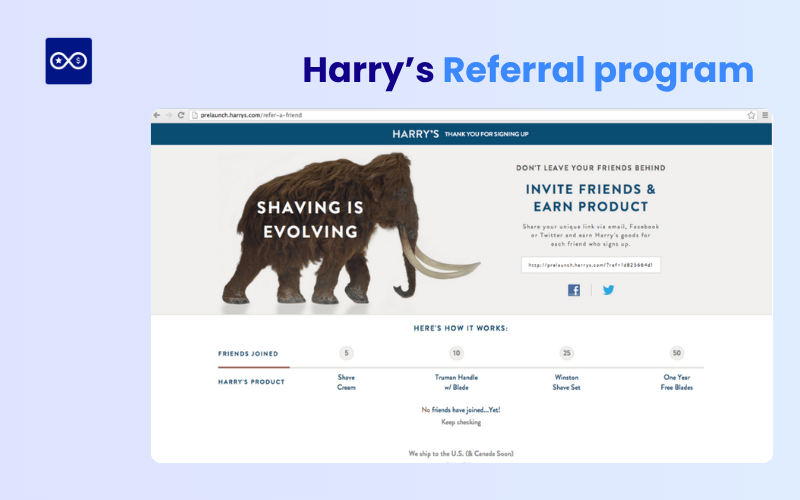
Use Segmentation and Targeting
Identify and heavily promote the referral program to your top-performing, loyal customers who are most likely to refer others. Segment your email lists for tailored messaging, such as targeting customers with multiple purchases but not yet referring.
Run Referral Contests and Gamification
Make sharing fun and engaging by running contests where customers compete for bigger rewards based on the number of referrals they generate. Gamification, like tiered rewards or limited-time bonuses, drives urgency and participation.
Simplify the Referral Process
Provide easy-to-share referral links, integrated referral buttons, referral QR code and straightforward instructions. The frictionless referral experience maximizes participation and lead generation.
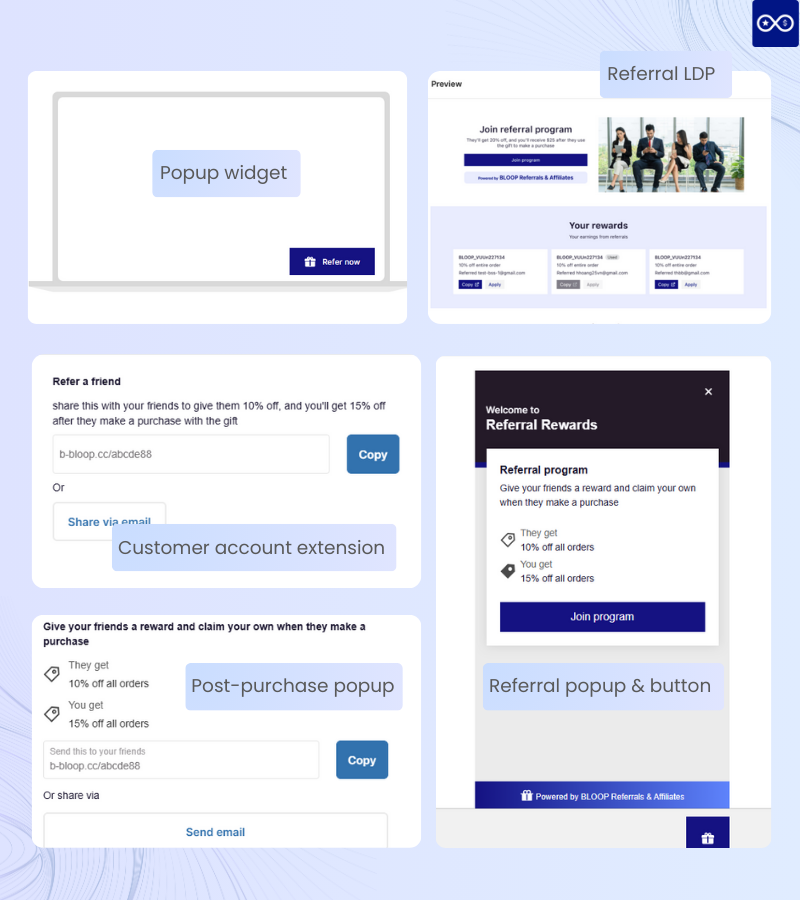
Monitor, Track, and Optimize
Use referral program software to track key performance indicators (KPIs). Analyze what incentives and channels work best, then optimize messaging, rewards, and marketing tactics continuously to improve lead acquisition rates.
>> You may also like: 20+ Referral Program Ideas For eCommerce That Definitely Works in 2026
Start your free Bloop Referral & Affiliate Program today and instantly reward your customers for sharing your store with friends. Set up automated referral links, popups, and rewards – all seamlessly integrated into your Shopify store.
- Grow your sales with word-of-mouth marketing
- Reward loyal customers and partners effortlessly
- Track referrals and commissions with ease
- Customize your referral page and emails to match your brand
Try Bloop free now and watch your Shopify store grow through trusted customer referrals and influencer partnerships!